This article was co-authored by Jason Myerson, DPT, DMT, OCS, FAAOMPT and by wikiHow staff writer, Eric McClure. Jason Myerson is a Physical Therapist and a Certified Orthopedic Specialist. He is affiliated with Performance Physical Therapy & Wellness with clinics located in Connecticut. He serves as adjunct faculty in the Physical Therapy Department at Quinnipiac University. Jason specializes in helping active people get back to hobbies, activities, and sports they love while utilizing an integrated approach to wellness. He holds an MA in Physical Therapy from Quinnipiac University and a Doctorate in Physical Therapy (DPT) from Arcadia University. He is Residency and Fellowship trained in Orthopedic Manual Therapy, achieved a Doctorate in Manual Therapy (DMT) and became a Fellow of the American Academy of Orthopedic Manual Physical Therapists (FAAOMPT).
There are 11 references cited in this article, which can be found at the bottom of the page.
This article has been viewed 79,220 times.
If you’ve ever sat up after getting lost in a good book for a few hours and discovered that your neck, back, or legs were sore, you’re not alone. It’s easy to get caught up in your reading and end up shifting into an unhealthy position that feels right at the time, but is ultimately not very good for your body. The goal of reading with proper posture is to maintain a neutral spine where your back is lined up perfectly over your hips to avoid putting unnecessary strain on your body. Remember to take frequent breaks while you’re reading for an extended period of time. If you don’t, you may get sore or strain a muscle regardless of the position you’re sitting in.
Steps
Sitting Correctly
-
1Maintain a straight spine while reading to avoid back pain. The straighter that you can keep your spine, the less pressure you’re putting on your lower back. If you’re sitting, rest your butt against the junction where the back of the chair meets the seat. Alternatively, if you’re lying down, keep your spine level with your neck. This will make it easier to keep your spine straight without even thinking about it![1]
- This will also make it impossible for you to lean too far back if you’re in a chair, since your tailbone will be directly underneath your spine.
- Don’t worry if this feels a little goofy at first. Many people naturally develop poor posture over the years, but it’s nothing some good habits can’t change. You’ll get used to this over time.
- The term “straight spine” is a little misleading, since you have some natural curvature in your back. You know that your spine is straight if your shoulders are directly over your hips and your back is firm and upright.
-
2Keep your head straight and avoid tilting your neck. Keep your neck aligned with your spine and move your eyes to read from line to line instead of moving your entire head. Unless you’re deliberately stretching your neck out, tilting your head at an angle will result in neck strain. It will also throw your center of gravity slightly off, which may inadvertently put some light pressure on your back.[2]
- If you’ve got a cushion on the top of your chair, use it as a headrest to keep your head still.
Advertisement -
3Hold the book up a little under eye-level to avoid slouching forward.[3] Keep your elbows bent and hold the book up a little beneath your eyes. If you hold the book down near your lap, you’ll bend your neck down while reading, which will strain your neck and upper back muscles while you enjoy your book.[4]
- Resting your elbows on a table or armchair will make this easier to do over a longer period of time. Otherwise, you can rest your elbows against your sides and bring the book a little closer to your eyes than you normally would.
- If you prefer to use an e-reader, opt for a lightweight model to make it easier to hold up in front of you.
-
4Read in a seat that allows your feet to reach the ground if possible. It is difficult to maintain proper posture if your feet can’t touch the ground.[5] For ideal posture, choose a comfortable seat with a straight back that will allow you to rest your entire back against the chair. Any chair, sofa, or bench can work so long as you can sit with your knees at a 90-degree angle and your feet flat on the floor.[6]
- Recliners are great for maintaining good posture—especially if they have a footrest. Tilting your spine back 15-30 degrees while keeping your knees at a 90-degree angle is a great way to ensure that your spine stays straight. It tends to be a little harder to hold a book up in one of these chairs, though.
- While it may seem counterintuitive, a straight-backed chair is actually better for your posture than a soft sofa. You can still put a cushion on the straight-backed chair to make it more comfortable if you’d like.
- If you're reading in bed, prop yourself up against the headrest or wall with a pillow behind your back for more support.[7]
Tip: A cushioned chair with armrests is ideal. The cushions will keep you comfortable while the armrests will make it easier to keep your book raised up.
-
5Set your device on a small table or stand if you use a laptop or e-reader.[8] Get a laptop stand or small adjustable table and set it down in front of you. Set your laptop or e-reader on top of the stand or table so that the screen rests a little under eye level. If the device is on a platform, you won’t need to slump forward to look at it, which can cause neck pain.[9]
- There are plenty of cheap options for e-reader stands and using one will keep your arms from getting tired from holding the e-reader up. When your arms get tired, you’re bound to lower them eventually which will cause you to tilt your head down.
Staying Comfortable and Preventing Strain
-
1Keep the room well-lit to avoid straining your eyes or moving your neck. If the room is dark, you’ll struggle to focus your eyes on the text. This means that you’ll naturally squint your eyes and lean forward a little to get a better look at the words. If you’re leaning forward, your spine won’t be straight and your neck will be tilted over your lap. This can lead to a sore back and neck, in addition to strained eyes.[10]
- If you’re using a digital e-reader or laptop, make the brightness of the screen lower than the brightest light in the room. It’s relatively difficult for your eyes to focus on a bright digital screen against a dim background. If the digital screen is the brightest source of light in the room, it will strain your eyes and lead to headaches or eye pain.[11]
-
2Prop your feet up to keep your spine straight if you’re sitting and need support. You can sit with your feet planted on the floor at a 90-degree angle, but if you’re struggling to keep your spine straight, prop your feet up a little. Get a small footstool or ottoman and rest your feet on it so that they’re raised 6–12 inches (15–30 cm) off of the floor. Keep both feet flat on the surface of the platform.[12]
Tip: Leaning forward while reading isn’t great for your back since you’re putting pressure on your lower back and reducing the circulation your legs. It’s harder to naturally lean forward if your feet are elevated a little.
-
3Slide a rolled-up towel behind your lower back if it gets sore. For some people, it’s more comfortable to cushion the lower back and brace it with additional support.[13] If your back is getting sore while you’re seated, grab a small towel or cloth and roll it up. After sitting down, slide the towel behind your lower back, just above the edge of your tailbone.[14]
- You can use a small pillow instead of a towel if you prefer.
- You’re not harming your posture by adding a cushion or towel. If you’re comfortable, it’s a good sign that your posture is correct!
- Giving the lower back additional cushioning is a great way to make sure you aren’t leaning forward or back as well, since you’ll be able to feel the towel sliding down if you lean forward, or compressing against the chair if you lean back.
-
4Take a 5-minute break every hour to avoid muscle strain.[15] After 60 continuous minutes of reading, stand up and walk around for a few minutes. Do some simple stretches or callisthenic exercises. You don’t need to work up a sweat or anything, but a little bit of movement will stretch your muscles out and make it less likely that you get sore while you’re reading.[16]
- Jumping jacks are a great simple way to work your body out for a minute or two.
- Stretch your arms, roll your neck around the stretch the muscles out, and bend over to touch your toes. You don’t need a full workout or stretching session; a few simple stretches will do the tricks just fine
-
5Stretch your legs out in front of you periodically to keep the blood moving. While seated, your legs will be prone to falling asleep and stiffening up. To keep them from tightening up, stick your legs out in front of you and roll your ankles around in the air. Doing this for 5-10 seconds every once in a while will keep your legs from cramping up or falling asleep. A little physical movement will also help your body stay comfortable while you’re sitting for a long period of time.[17]
Expert Q&A
Did you know you can get expert answers for this article?
Unlock expert answers by supporting wikiHow
-
QuestionHow can I read without straining my neck?
 Jason Myerson, DPT, DMT, OCS, FAAOMPTJason Myerson is a Physical Therapist and a Certified Orthopedic Specialist. He is affiliated with Performance Physical Therapy & Wellness with clinics located in Connecticut. He serves as adjunct faculty in the Physical Therapy Department at Quinnipiac University. Jason specializes in helping active people get back to hobbies, activities, and sports they love while utilizing an integrated approach to wellness. He holds an MA in Physical Therapy from Quinnipiac University and a Doctorate in Physical Therapy (DPT) from Arcadia University. He is Residency and Fellowship trained in Orthopedic Manual Therapy, achieved a Doctorate in Manual Therapy (DMT) and became a Fellow of the American Academy of Orthopedic Manual Physical Therapists (FAAOMPT).
Jason Myerson, DPT, DMT, OCS, FAAOMPTJason Myerson is a Physical Therapist and a Certified Orthopedic Specialist. He is affiliated with Performance Physical Therapy & Wellness with clinics located in Connecticut. He serves as adjunct faculty in the Physical Therapy Department at Quinnipiac University. Jason specializes in helping active people get back to hobbies, activities, and sports they love while utilizing an integrated approach to wellness. He holds an MA in Physical Therapy from Quinnipiac University and a Doctorate in Physical Therapy (DPT) from Arcadia University. He is Residency and Fellowship trained in Orthopedic Manual Therapy, achieved a Doctorate in Manual Therapy (DMT) and became a Fellow of the American Academy of Orthopedic Manual Physical Therapists (FAAOMPT).
Physical Therapist & Certified Orthopedic Specialist Physical Therapist & Certified Orthopedic SpecialistExpert AnswerThink about where you're setting up. For example, if you're sitting up in bed, head down and slouched, that puts a lot of tension on your neck tissues and the tissues of your low back. If you have a higher dresser in your house, I recommend using it as a standing desk and standing for maybe 45 minutes to an hour a few times a day instead. It’s a free way to improve your posture.
Physical Therapist & Certified Orthopedic SpecialistExpert AnswerThink about where you're setting up. For example, if you're sitting up in bed, head down and slouched, that puts a lot of tension on your neck tissues and the tissues of your low back. If you have a higher dresser in your house, I recommend using it as a standing desk and standing for maybe 45 minutes to an hour a few times a day instead. It’s a free way to improve your posture. -
QuestionWhat are the symptoms of bad posture?
 Jason Myerson, DPT, DMT, OCS, FAAOMPTJason Myerson is a Physical Therapist and a Certified Orthopedic Specialist. He is affiliated with Performance Physical Therapy & Wellness with clinics located in Connecticut. He serves as adjunct faculty in the Physical Therapy Department at Quinnipiac University. Jason specializes in helping active people get back to hobbies, activities, and sports they love while utilizing an integrated approach to wellness. He holds an MA in Physical Therapy from Quinnipiac University and a Doctorate in Physical Therapy (DPT) from Arcadia University. He is Residency and Fellowship trained in Orthopedic Manual Therapy, achieved a Doctorate in Manual Therapy (DMT) and became a Fellow of the American Academy of Orthopedic Manual Physical Therapists (FAAOMPT).
Jason Myerson, DPT, DMT, OCS, FAAOMPTJason Myerson is a Physical Therapist and a Certified Orthopedic Specialist. He is affiliated with Performance Physical Therapy & Wellness with clinics located in Connecticut. He serves as adjunct faculty in the Physical Therapy Department at Quinnipiac University. Jason specializes in helping active people get back to hobbies, activities, and sports they love while utilizing an integrated approach to wellness. He holds an MA in Physical Therapy from Quinnipiac University and a Doctorate in Physical Therapy (DPT) from Arcadia University. He is Residency and Fellowship trained in Orthopedic Manual Therapy, achieved a Doctorate in Manual Therapy (DMT) and became a Fellow of the American Academy of Orthopedic Manual Physical Therapists (FAAOMPT).
Physical Therapist & Certified Orthopedic Specialist Physical Therapist & Certified Orthopedic SpecialistExpert Answer
Physical Therapist & Certified Orthopedic SpecialistExpert Answer -
QuestionHow should I sleep if I want to fix my posture?
 Jason Myerson, DPT, DMT, OCS, FAAOMPTJason Myerson is a Physical Therapist and a Certified Orthopedic Specialist. He is affiliated with Performance Physical Therapy & Wellness with clinics located in Connecticut. He serves as adjunct faculty in the Physical Therapy Department at Quinnipiac University. Jason specializes in helping active people get back to hobbies, activities, and sports they love while utilizing an integrated approach to wellness. He holds an MA in Physical Therapy from Quinnipiac University and a Doctorate in Physical Therapy (DPT) from Arcadia University. He is Residency and Fellowship trained in Orthopedic Manual Therapy, achieved a Doctorate in Manual Therapy (DMT) and became a Fellow of the American Academy of Orthopedic Manual Physical Therapists (FAAOMPT).
Jason Myerson, DPT, DMT, OCS, FAAOMPTJason Myerson is a Physical Therapist and a Certified Orthopedic Specialist. He is affiliated with Performance Physical Therapy & Wellness with clinics located in Connecticut. He serves as adjunct faculty in the Physical Therapy Department at Quinnipiac University. Jason specializes in helping active people get back to hobbies, activities, and sports they love while utilizing an integrated approach to wellness. He holds an MA in Physical Therapy from Quinnipiac University and a Doctorate in Physical Therapy (DPT) from Arcadia University. He is Residency and Fellowship trained in Orthopedic Manual Therapy, achieved a Doctorate in Manual Therapy (DMT) and became a Fellow of the American Academy of Orthopedic Manual Physical Therapists (FAAOMPT).
Physical Therapist & Certified Orthopedic Specialist Physical Therapist & Certified Orthopedic SpecialistExpert AnswerTake a deep breath and don't stress. The pain caused by sleeping incorrectly is usually not serious. If you're a side sleeper, consider placing a pillow between your knees. This can take a lot of stress off your lower back and the upper hips muscles. For people that sleep on their back, I would recommend laying on your back with a pillow behind your knees. This can take some stress off some of the tissues of your lower back as well.
Physical Therapist & Certified Orthopedic SpecialistExpert AnswerTake a deep breath and don't stress. The pain caused by sleeping incorrectly is usually not serious. If you're a side sleeper, consider placing a pillow between your knees. This can take a lot of stress off your lower back and the upper hips muscles. For people that sleep on their back, I would recommend laying on your back with a pillow behind your knees. This can take some stress off some of the tissues of your lower back as well.
References
- ↑ https://my.clevelandclinic.org/health/articles/4485-back-health-and-posture
- ↑ https://medlineplus.gov/guidetogoodposture.html
- ↑ Jason Myerson, DPT, DMT, OCS, FAAOMPT. Physical Therapist & Certified Orthopedic Specialist. Expert Interview 15 April 2020.
- ↑ https://webwriterspotlight.com/correct-postures-for-reading-books
- ↑ Jason Myerson, DPT, DMT, OCS, FAAOMPT. Physical Therapist & Certified Orthopedic Specialist. Expert Interview 15 April 2020.
- ↑ https://medlineplus.gov/guidetogoodposture.html
- ↑ https://www.wsj.com/articles/is-it-healthy-to-study-in-bed-11550077336
- ↑ Jason Myerson, DPT, DMT, OCS, FAAOMPT. Physical Therapist & Certified Orthopedic Specialist. Expert Interview 15 April 2020.
- ↑ https://www.spine-health.com/blog/10-best-ergonomic-laptop-setup-tips
- ↑ https://opto.ca/health-library/why-proper-lighting-is-important-while-reading
- ↑ https://www.bbc.com/future/article/20121001-should-you-read-in-the-dark
- ↑ https://webwriterspotlight.com/correct-postures-for-reading-books
- ↑ Jason Myerson, DPT, DMT, OCS, FAAOMPT. Physical Therapist & Certified Orthopedic Specialist. Expert Interview 15 April 2020.
- ↑ https://my.clevelandclinic.org/health/articles/4485-back-health-and-posture
- ↑ Jason Myerson, DPT, DMT, OCS, FAAOMPT. Physical Therapist & Certified Orthopedic Specialist. Expert Interview 15 April 2020.
- ↑ https://uhs.umich.edu/computerergonomics
- ↑ https://lluh.org/services/neuropathic-therapy-center/blog/5-ways-sitting-killing-your-nerves
- ↑ https://www.theguardian.com/lifeandstyle/2018/mar/05/are-you-sitting-comfortably-the-myth-of-good-posture
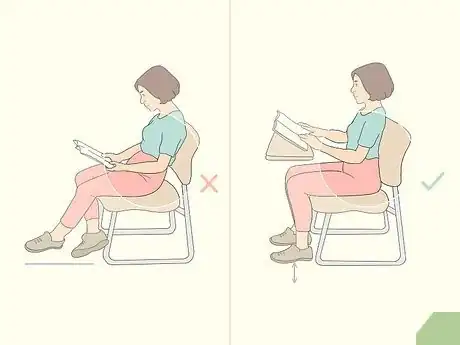
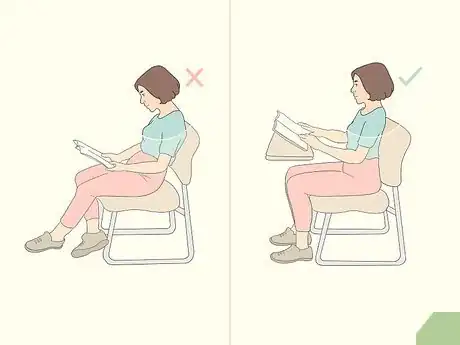
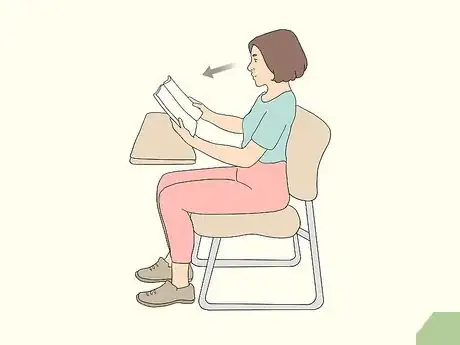

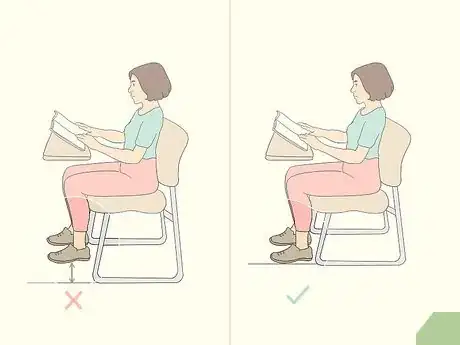


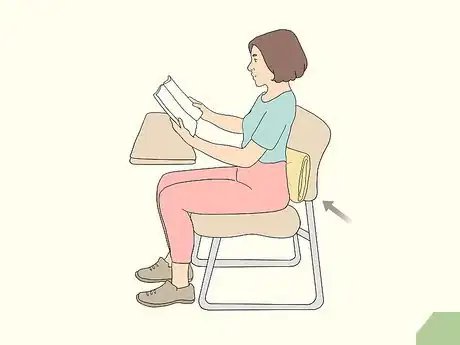

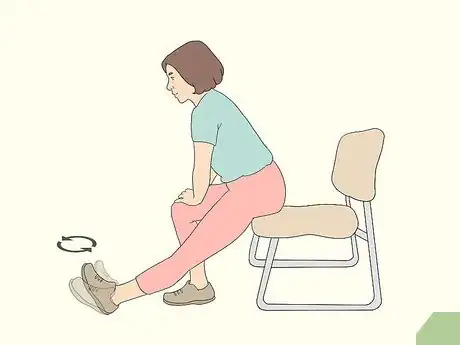

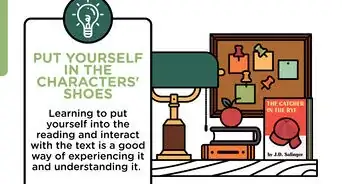

























































Medical Disclaimer
The content of this article is not intended to be a substitute for professional medical advice, examination, diagnosis, or treatment. You should always contact your doctor or other qualified healthcare professional before starting, changing, or stopping any kind of health treatment.
Read More...